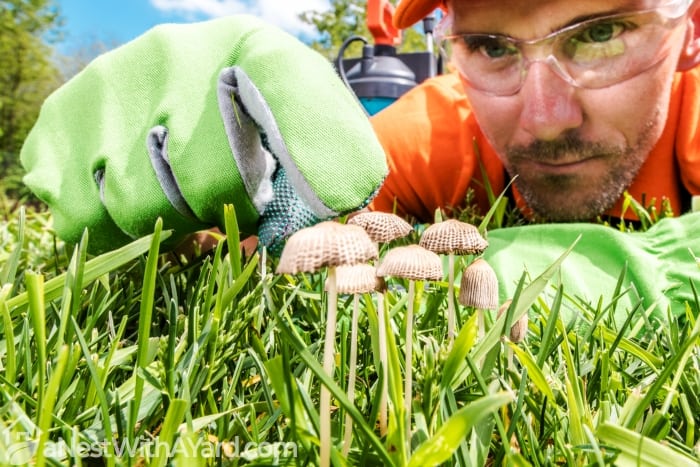Have you spotted pesky mushrooms popping up here and there on your lawn? These lawn mushrooms can be quite unsightly and ruin the aesthetic appeal of your yard. To make things worse, they can also be harmful to kids and pets.
Keen to learn more about how to get rid of mushrooms and get your yard looking pristine and as good as new? Keep reading to find out everything you need to know!
A Good Dose Of Fungicide
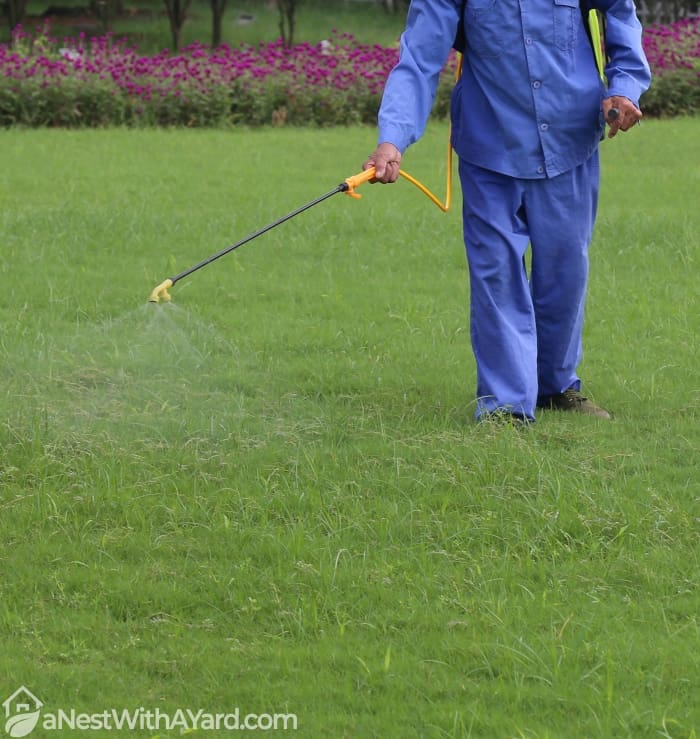
Sometimes the easiest route to go is by using fungicide. Mushroom spores contain everything needed to form new fungus. Once the mushroom spores are released, they’ll send out hyphae, which will establish the fungus.
When new fungus is formed, mushrooms grow out of it beneath the soil. So, when you apply fungicide, you’ll kill off the fungi at the root of the mushroom.
What Will You Need
- Good quality fungicide
- Sprayer attachments for your garden hose OR a backpack sprayer
- Shovel
Step By Step
- Remove any viable mushrooms growing from your lawn.
- Dispose of the mushrooms, as well as any decaying matter on your lawn.
- Get your equipment ready. Simply attach the hose sprayer attachment to your fungicide bottle.
Image credit: https://www.holmanindustries.com.au/ - Take a walk through your yard and spray it thoroughly. Pay special attention to the areas where you removed the mushrooms.
A Spritz Of Vinegar
If you’re looking for a natural way to get rid of mushrooms from your grass, using horticulture vinegar might be the way to go. Bear in mind that cooking or household vinegar isn’t as potent as horticulture vinegar and far too diluted to get the job done.
However, horticulture vinegar can be extremely harmful and burn skin, so if you plan on trying out this method, it is very important to exercise safety measures. These can include ensuring that no kids or pets are nearby when applying the vinegar or immediately after application, wearing protective gear, and being careful about diluting and storing the vinegar before, during, and after use.
You might be thinking “why should I even bother getting rid of these mushrooms if the process itself can be harmful?” Remember, it’s best not to take any chances regarding poisonous mushrooms. Rather than assuming that they’re safe, you might as well get rid of mushrooms before they cause you any unwanted problems, especially if you have kids and pets.
What Will You Need
- Horticulture vinegar
- Water for dilution
- A spray bottle
- Gloves
- Eye protection
Step By Step
- Dilute the horticulture vinegar in water according to package instructions. You can use a spray bottle for this.
- Spray the mushrooms with the vinegar solution.

- Make sure you don’t spray the solution on the surrounding grass as it could burn it.
- Come back to the treated area in a couple of days to see whether the solution has had any effect on the mushrooms.
- If it hasn’t, apply a second dose of the vinegar solution.
Keen to learn more about lawn care? Check this out!
A Sprinkle Of Baking Soda
Baking soda, also known as bicarbonate of soda, is another way to go if you are looking for a more natural way to get rid of mushrooms. As bicarbonate of soda has a number of uses, it is often something that you will have in your home or is easily accessible.
This method is not a quick fix, but over time, it will reduce growth and even kill mushrooms. It does this by increasing the soil’s pH level, causing the mushroom growth to be hindered. While this is not really a permanent solution, it is a gentle, safe, and effective option to prevent mushroom growth.
What Will You Need
- Two tablespoons of baking soda per gallon of water
- A spray bottle/watering can/hose pipe
- Water for mixing
Step By Step
- Mix your bicarbonate of soda and water together until the solution is dissolved.
- Add the solution to your spray bottle.

- Spray the mix over all the mushrooms, as well as the surrounding soil.
Alternatively, you could also:
- Sprinkle the baking soda over the mushrooms as well as the surrounding soil.

- Pour water over the areas you’ve sprinkled with baking soda.
Curious about whether applying weed and feed before rain will promote the growth of pesky mushrooms? Check this out for more information!
A Dash Of Dish Soap
Looking for something to use that you likely already have lying around the house? How about using a dish soap and water mixture? Dish soap is another easy and natural way to get rid of your mushroom problem.
While you are likely to see a quick reduction in your mushrooms, this method does need to be repeated a few times a day, for at least a week. The soapy water mixture works by getting deep into the soil and interrupting the lawn mushrooms lifecycle from the roots. This means that it is key that the soap mixture gets deep into the soil.
What Will You Need
- Dish soap
- Water for dilution
- A tool to poke holes in the ground, such as a screwdriver
Step By Step
- Mix one to two tablespoons of whatever dish soap you have on hand in up to three gallons of water.
- Poke holes in the ground with your screwdriver (or whichever tool that will give the same result) around the mushrooms.

- Pour your mixture over the mushrooms and into the holes.
- Repeat several times a day for a week.
Adjust Your Lawn Maintenance Routine

Mushrooms thrive in environments where the ground is moist and there is a lack of light and airflow. Adjusting the way in which you maintain your lawn in a few easy steps is a simple way to help get rid of that pesky mushroom problem.
Since mushrooms love moisture, you should pay attention to how long you’re watering your grass or leaving your sprinklers on. Too much water could result in a comfortable breeding ground for pesky mushrooms to sprout.
Aerating your grass and adjusting your lawn mower blade height are two ways to adjust your maintenance routine to create an airy, bright and drier environment for your lawn. Mushrooms are generally quite delicate and, therefore, it’s easier to kill large mushrooms during mowing, and raking can dislodge smaller mushrooms.
When mowing your grass, be sure to remove all your grass clippings to prevent them from becoming dead grass which could lock in moisture and prevent light from reaching your soil, therefore creating an environment that would encourage the growth of mushrooms rather than creating one that will kill mushrooms.
What Will You Need
- A lawn mower with sharp blades
- An aerating tool
- A rake
Step By Step
- Lower the height of your mower blades to give a shorter cut.
Check out this video by YouTube user Cornell SIPS for an easy explanation of how to lower your lawn mower blades:
- Mow your grass.
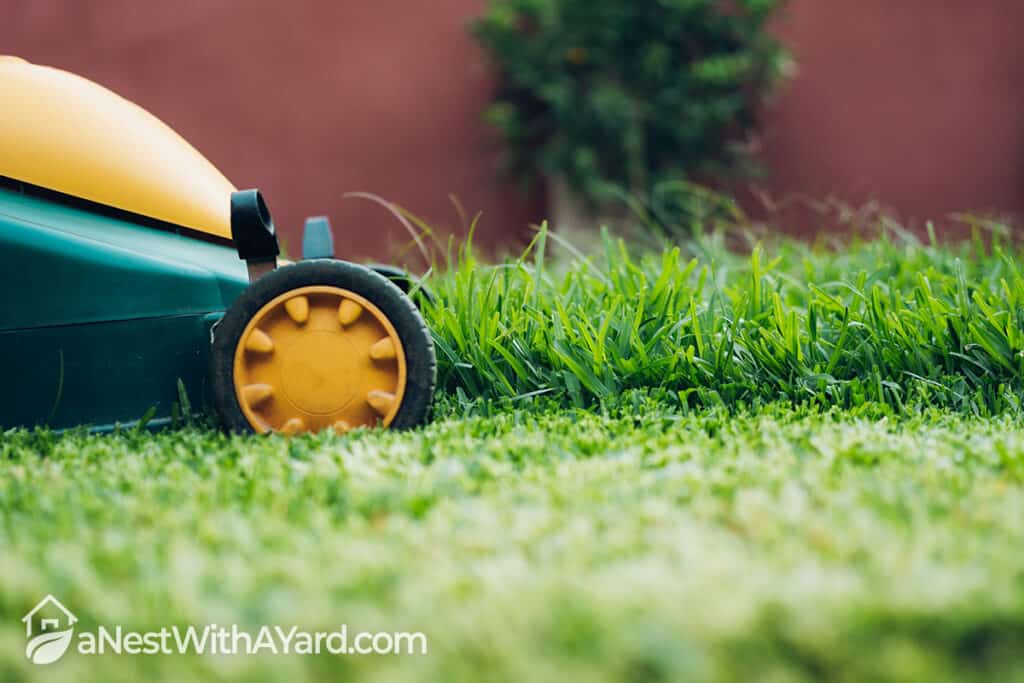
- Remove the grass clippings.
- Water your soil. It’s best to water in the morning, as this will allow the sun to dry off any excess moisture during the day.
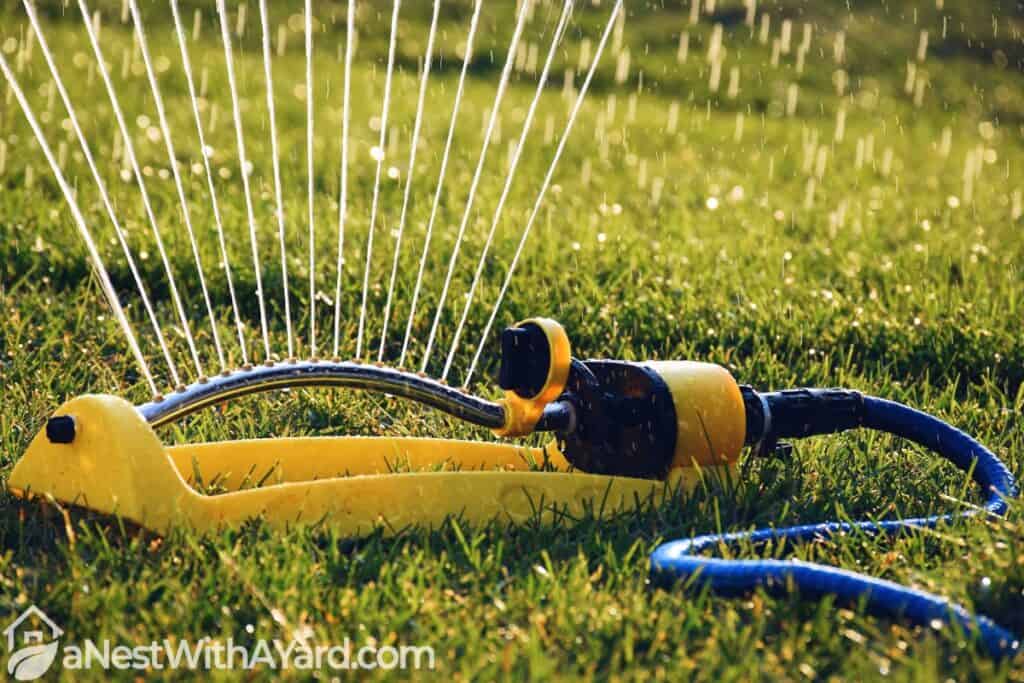
- Select your aerating tool.
- Aerate your yard.
Check out this informative video by Lawn Solutions Australia for a detailed account of how to aerate your lawn:
- Resume regular lawn care with the adjusted level of mowing.
Remove Any Organic Material
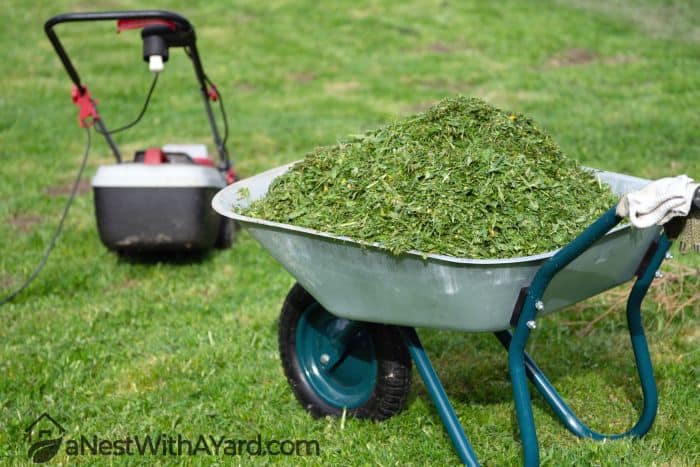
Removal of decaying organic material, in particular, is important in preventing mushroom growth. Material such as rotting leaves, branches, grass clippings or dead grass and animal waste can encourage mushroom growth because they become a food source for lawn fungi.
Cleaning up your mulch is also a good idea. This is because, while having mulch in your yard does help your grass in some instances, its purpose is to keep the soil temperature down and retain moisture, which creates the perfect environment for mushrooms to grow.
While some organic materials, such as plant residues and manure, can improve the health of your soil and plant and are therefore beneficial, if you wish to reduce mushroom growth in your yard, it is best to remove as much organic material from your yard as possible – at least for the time being so that you are able to reduce the mushroom’s food source.
The two most common types of mushrooms to keep an eye out for are the meadow mushroom (also known as agaricus campestris) and the lawyer’s wig (also known as coprinus comatus). Both these types of mushrooms are considered to be edible.
There is another common type called destroying angel (also known as amanita bisporigera), which is not edible and is in fact incredibly poisonous. Therefore, as we mentioned earlier on, it’s best not to take any chances when it comes to poisonous mushrooms and to not make the assumption that they’re “probably safe”.
What Will You Need
- Gloves
- Spade/rake – depending on the type and texture of the organic material you need to remove
Step By Step
- Remove all decaying organic waste like grass clippings and animal waste from your lawn.
- Discard of them properly and make sure they don’t find their way back in somehow.
FAQs
Should I Remove Mushrooms From My Lawn?
You should remove mushrooms from your lawn because they can ruin the aesthetic of your yard. While most mushrooms are harmless, you can get a few types that can prove to be poisonous. Therefore, it’s best to remove them from your grass, especially if you have pets and kids.
What Kills Mushrooms In Your Lawn?
Fungicide kills mushrooms in your lawn. You can DIY your own fungicide at home using ingredients such as vinegar and soap, or buy some from your local nursery. There are several different types of fungicide to choose from that range in texture, ingredients and application methods.
What Causes Mushrooms To Grow In Your Lawn?
Prolonged humid and wet weather conditions cause mushrooms to grow in your lawn. The excess moisture causes fungi to sprout, which develops into the mushrooms you see on the surface of your grass.
Now You Know How To Get Rid Of Mushrooms
Lawn mushrooms can be quite bothersome, especially if you’re an avid gardener who works extra hard to keep your yard looking nice and tidy. Worst of all, they can even be poisonous, so it’s always a good idea to remove them as soon as you spot them sprouting.
These pesky mushrooms are now a thing of the past in my yard since I tried out the soap method, and I hope you find that it helps you get your yard back to normal soon! I know there’s nothing more frustrating than trying everything you can to fix a problem and nothing works. No need to worry about this, though, because these methods are sure to be helpful!
I hope you found this article useful! If you try out any of our methods, please leave a comment below and share this with a friend. We’d love to hear from you!


